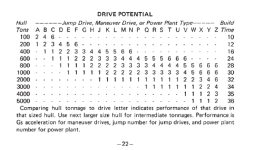pesco
SOC-9
Hi all,
As I mentioned in another thread, I only recently came across Traveller and have been making my way through my "Little White Books" (Facsimile Edition of 1981 CT).
Regarding the ship construction rules of Book 2, specifically the formula for fuel tankage (p. 15),
where M is the mass of the ship, Jn is the "jump number" and Pn is the "power number". I am looking at this in conjunction with the Drive Potential Table (p. 22), which yields the power number for a given hull tonnage and power plant type (letter). The same table is also used for jump number and maneuver drive acceleration.

Cutting to the chase, it seems strange to me that power number, and thus fuel requirements, decrease as hull tonnage increases. All other things being equal, a bigger ship requires less fuel to maneuever!? I am looking at the right-hand side of the equation (10 Pn); the left is specifically stated to be (only) for jumping. For example, a 400 ton ship with a type M power plant requires 60 tons of fuel tankage for regular operation. Increasing the ship's tonnage to 1000 tons (padding it with bulkheads and filler bunnies, presumably) drops the maneuvering fuel requirement to 20 tons, the same as a 100 ton type S Scout/Courier. Yay filler bunnies!
I can only speculate that this may simply be an artefact of not wanting to introduce yet another table, but it irked me enough that I spent some time thinking about it and I came up with the idea to use something like
or
for the fuel formula, where P is just the power plant's letter rating (A - Z sans I and O) converted to a number (1 - 24), same with D for the (maneuver) drive. Small ships would benefit and bigger ones would take a hit. But in any case, the problem with these formulas is probably their linearity which tends to feel unnatural. So maybe something like this instead:
with the original
Anyway, is this a stupid idea? Has it been rehashed to death? Am I completely missing something (aside from revised rules in other books)? Or is it something that could reasonably be made to work?
As I mentioned in another thread, I only recently came across Traveller and have been making my way through my "Little White Books" (Facsimile Edition of 1981 CT).
Regarding the ship construction rules of Book 2, specifically the formula for fuel tankage (p. 15),
0.1 M Jn + 10 Pn
where M is the mass of the ship, Jn is the "jump number" and Pn is the "power number". I am looking at this in conjunction with the Drive Potential Table (p. 22), which yields the power number for a given hull tonnage and power plant type (letter). The same table is also used for jump number and maneuver drive acceleration.

Cutting to the chase, it seems strange to me that power number, and thus fuel requirements, decrease as hull tonnage increases. All other things being equal, a bigger ship requires less fuel to maneuever!? I am looking at the right-hand side of the equation (10 Pn); the left is specifically stated to be (only) for jumping. For example, a 400 ton ship with a type M power plant requires 60 tons of fuel tankage for regular operation. Increasing the ship's tonnage to 1000 tons (padding it with bulkheads and filler bunnies, presumably) drops the maneuvering fuel requirement to 20 tons, the same as a 100 ton type S Scout/Courier. Yay filler bunnies!
I can only speculate that this may simply be an artefact of not wanting to introduce yet another table, but it irked me enough that I spent some time thinking about it and I came up with the idea to use something like
0.1 M Jn + 4 P
or
0.1 M Jn + 5 D + 3 P
for the fuel formula, where P is just the power plant's letter rating (A - Z sans I and O) converted to a number (1 - 24), same with D for the (maneuver) drive. Small ships would benefit and bigger ones would take a hit. But in any case, the problem with these formulas is probably their linearity which tends to feel unnatural. So maybe something like this instead:
Code:
A B C D E F G H J K L M N P Q R S T U V W X Y Z
Pn 1 2 2 3 3 3 4 4 4 4 5 5 5 5 5 6 6 6 6 6 6 7 7 7with the original
0.1 M Jn + 10 Pn .
Anyway, is this a stupid idea? Has it been rehashed to death? Am I completely missing something (aside from revised rules in other books)? Or is it something that could reasonably be made to work?

